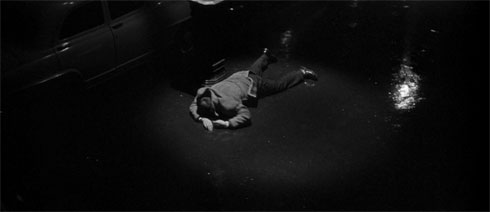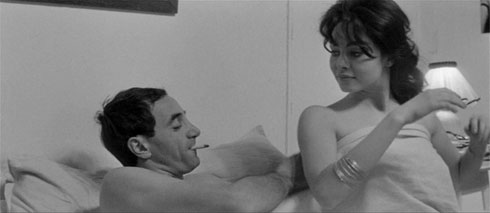A part of this viewing list: Criterion Collection Spine #315: François Truffaut’s Shoot The Piano Player.

I only have ten more films to rewatch in The Criterion Collection before I can start watching stuff I haven’t seen before again. I’m looking forward to that day. Here’s a little context about Shoot the Piano Player. It is considered part of the French New Wave, and its director, François Truffaut, one of the premier nouvelle vague auteurs. It is based on a pulp fiction novel by David Goodis called Down There. The film is much better than the novel. This is also one of those films that sends academics into sharklike slavering fits due more to its context than its quality. That isn’t to say it is a crummy film. It is very entertaining, poignant, polished and still fresh after nearly 50 years.

But the Möbius strip feedback between the film, its differentiation as French film noir from American film noir, its self-awareness, its obvious undercutting of expectation, and its humor lend the focus more on Truffaut’s direction, the mechanism, rather than the content. That is really only to be expected, since the general content, apart from the aforementioned undercut expectations, is nothing really new. Despite the fact that there is a suicide, a few murders and some kidnapping, a sort of dynamic equilibrium is maintained with brief philosophic interludes and consistent humor. The result is a film that leaves a viewer sated on all fronts, gorged or starved on none.

The most interesting character is, of course, the piano player: Charlie/Edouard. There is a remarkable amount of his character exposition in a film that is only 81 minutes long. At times the viewer is privy to his inner monologue, but ultimately he remains a mystery and his obsession with the piano a simultaneous blessing and curse. Still, this unsolved mystery doesn’t leave any dissatisfaction, as it is obvious that Charlie is content with his lot, as long as there is a piano within finger range. Charlie reminds me of this opening passage:
Current-borne, wave-flung, tugged hugely by the whole might of the ocean, the jellyfish drifts in the tidal abyss. The light shines through it, and the dark enters it. Borne, flung, tugged from anywhere to anywhere, for in the deep sea there is no compass but nearer and farther, higher and lower, the jellyfish hangs and sways; pulses move slight and quick within it, as the vast diurnal pulses beat in the moondriven sea. Hanging, swaying, pulsing, the most vulnerable and insubstantial creature, it has for its defense the violence and power of the whole ocean, to which it has entrusted its being, its going, and its will.
-Ursula K. LeGuin The Lathe of Heaven

While Charlie isn’t quite as passive as a jellyfish, he does have a certain stoic acceptance of the situations he finds himself in. The only time he is visibly agitated is when Lena is in danger. The rest of their characters play their parts, so it really is the manner of the film-making, the gimmick shots, the sight gags, the undercurrent of smartassed French humor that gives the film its pep.

• Criterion Essay by Kent Jones.
• Carter B. Horsley Review.
• Tom Huddleston Review.
• Pulp cover of David Goodis’s Down There.
• YouTube clips [1, 2].